
The B-29 is an iconic aircraft that played a crucial role in World War II and the dawn of the atomic age.
Want to witness one of these birds in person? You are lucky as a select few have been carefully preserved and restored for future generations to marvel at.
In this article, we’ll take you on a captivating journey to the must-visit locations where you can experience the majesty of these colossal aircraft up close. So buckle up and prepare for takeoff as we embark on an extraordinary adventure to explore the surviving B-29 Superfortresses and the stories that surround them.
By the way, if you’re interested in learning more about the B-29, check out our article on the must-known facts about this amazing aircraft.
Let’s dive right in!
A Little of History
Following the end of World War II, the B-29 airplanes were flown back to the United States and dispersed across airfields in California, Texas, Oklahoma, and Maryland. After salvaging usable parts, the B-29s shared the fate of the B-17s and B-24s, disassembled and melted down by scrap dealers.
As newer aircraft models emerged, the Air Force gradually retired the B-29 from service, culminating in the Strategic Air Command’s final B-29 bomber flight on November 4, 1954. Subsequently, the Navy acquired several B-29s for testing purposes at both the Aberdeen Proving Ground in Maryland and China Lake in California. Although the exact number of transferred aircraft remains undetermined, it is believed that at least fifty were sent to China Lake and around a dozen to Aberdeen.
Naval Weapons Center at China Lake
Located approximately 200 miles southwest of Castle Air Force Base, the Naval Weapons Center at China Lake has long been a testing ground for various types of aircraft and weapons. This expansive facility has welcomed decommissioned airplanes and helicopters of all sorts, providing a secure environment for pilots to engage in target practice using machine guns, cannons, napalm, bombs, and other destructive means.
In the aftermath of World War II, China Lake received a substantial number of B-29 Superfortresses that were deemed surplus by the Air Force. Sadly, most of these historically significant aircraft met their end as targets, much to the dismay of present-day preservationists.
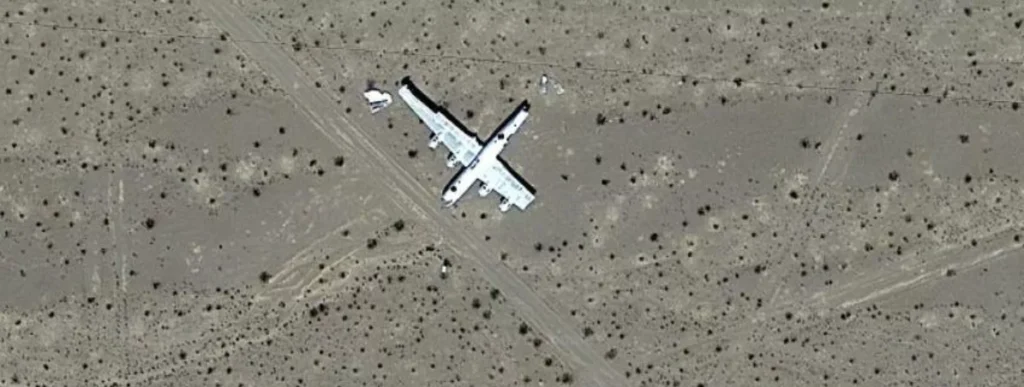
The remote location of China Lake’s ranges allowed the Navy to conduct live-fire exercises, launching weapons at flying drones and dropping ordnance on stationary targets. Consequently, the B-29 fleet stationed at China Lake fell victim to radar-guided bombs and missiles, leaving many of these iconic Superfortresses in ruins.
By the early 1970s, testing had annihilated almost all of the B-29s at China Lake. With only a few nearly intact examples remaining, aircraft museums competed fervently to acquire these rare pieces of aviation history.
Aberdeen Proving Ground
The Aberdeen Proving Ground in Maryland, a lesser-known aircraft testing site compared to its counterparts in Arizona, Texas, and California, played a significant role in the fate of many B-29 Superfortresses.
At Aberdeen, these aircraft underwent survivability testing, during which fuselage and wing sections were targeted by both existing and newly developed aircraft weapons. These tests allowed researchers to assess the damage, examine warhead fragmentation patterns, and explore ways to better protect aircrews and equipment.
By 1973, an astonishing quantity of B-29s, some sources say 500, had been completely destroyed by technicians conducting weapons tests at Aberdeen. However, the final eight surviving aircraft were spared from this fate and ultimately found homes in museums or military bases across Texas, Oklahoma, Georgia, Connecticut, Louisiana, and Missouri, after passing through New Hampshire.
Restoration and preservation efforts
Out of the nearly 4,000 B-29s built, only 26 remain, boasting an impressive 0.6 percent survivorship rate given their size and complexity. Among these survivors, two are flyable, 22 serve as static displays, and two are either in storage or undergoing restoration.
Not all survivors were combat veterans in the strategic bombing campaign against Japan during World War II; however, at least nine of them participated, including Enola Gay and Bockscar from the 509th Composite Group, while the other flew conventional bombardment missions.
Most of these aircraft, except for Enola Gay and Bockscar, were not preserved immediately after the war. Preservation efforts began in the 1970s, as several B-29s were rescued from locations like the Naval Air Weapons Station China Lake and Aberdeen Proving Ground, where they were initially sent for weapons testing.
These aircraft were restored and sent to museums in the United States and Great Britain. While the most valuable B-29s, such as Enola Gay and Bockscar, are displayed indoors, some are displayed outdoors due to their large size. Some of these outdoor exhibits are maintained under strict guidelines to ensure the protection and preservation of these historic artifacts.
For the complete list of surviving B-29s in just one table check out Surviving Boeing B-29 Superfortress Detailed List
Surviving B-29s Displayed indoor
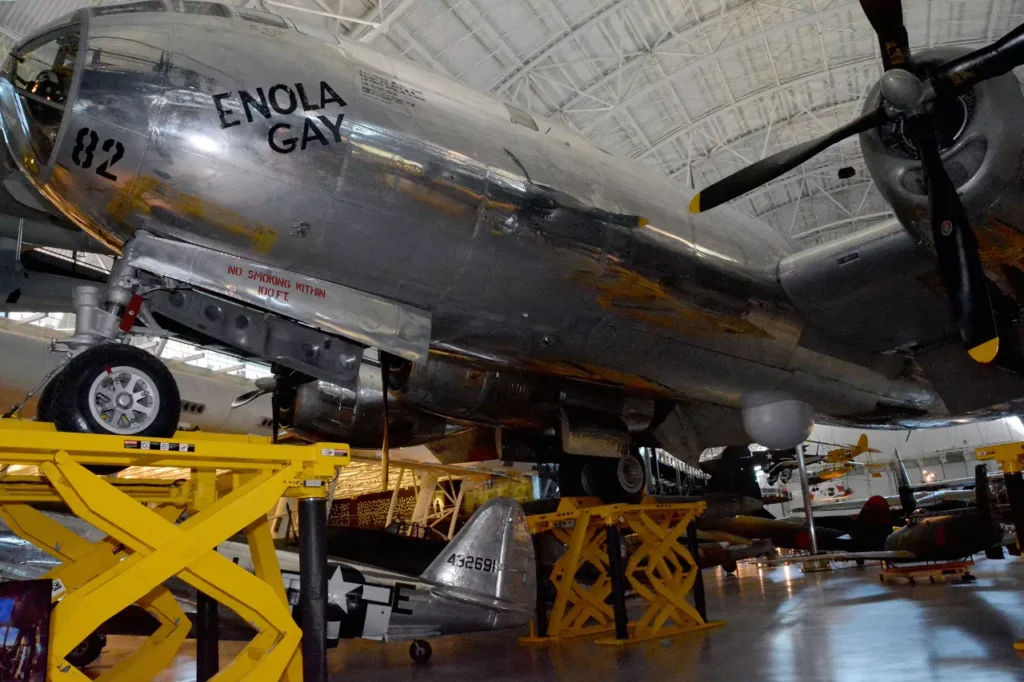
Eight surviving B-29s are on display indoors at various museums, with the two most significant being the Enola Gay and Bockscar.
The Enola Gay, arguably the most renowned aircraft in American history, is showcased at the National Air and Space Museum’s Steven F. Udvar-Hazy Center in Chantilly, Virginia.
Before you continue, make sure to explore the story of The Enola Gay.
Bockscar, the aircraft responsible for dropping the atomic bomb on Nagasaki, has been extensively restored and can be found at the National Museum of the U.S. Air Force at Wright-Patterson Air Force Base near Dayton, Ohio.
The eight B-29s on indoor display are:
| Serial | Model | Name | Frame | Location | State | Source |
|---|---|---|---|---|---|---|
| 44-27297 | B-29-40-MO | Bockscar | Complete | National Museum of the U.S. Air Force (NMUSAF) in Wright-Patterson AFB | Ohio | Inventory |
| 44-69729 | B-29-60-BW | T-Square 54 | Complete | Museum of Flight in Seattle | Washington | China Lake |
| 44-70016 | B-29-75-BW | Sentimental Journey | Complete | Pima Air and Space Museum in Tucson | Arizona | Inventory |
| 44-84053 | B-29B-55-BA | Big Red | Complete | Museum of Aviation in Robbins AFB | Georgia | Aberdeen PG |
| 44-84076 | B-29B-60-BA | Lucky Lady | Complete | Strategic Air Command & Aerospace Museum in Ashland | Nebraska | Inventory |
| 44-62022 | B-29A-60-BN | Peachy | Complete | Pueblo Wisboro Aircraft Museum in Pueblo | Colorado | China Lake |
| 44-61975 | B-29A-55-BN | Jack's Hack | Complete | New England Air Museum (NEAM) in Windsor Locks | Connecticut | Aberdeen PG |
| 44-86292 | B-29-35-MO | Enola Gay | Complete | Steven F. Udvar-Hazy Center in Chantilly | Washington DC | Inventory |
The Enola Gay controversy
In 1995, the Smithsonian Institution faced significant controversy over its plans to exhibit a restored portion of the Enola Gay’s fuselage on the National Air and Space Museum’s fiftieth anniversary.
Veteran groups, politicians, and donors criticized the museum for placing too much emphasis on the Japanese victims of the atomic blast. The original exhibition proposal aimed to showcase the historic B-29, Enola Gay, within a display that questioned the wisdom, morality, and necessity of the aircraft’s atomic bombing mission, primarily portraying the aggressor as the victim.
However, under the pressure, the exhibit was modified to allow visitors to form their own interpretations of the ethical implications of using the atomic bomb.
Surviving B-29s Displayed outdoor
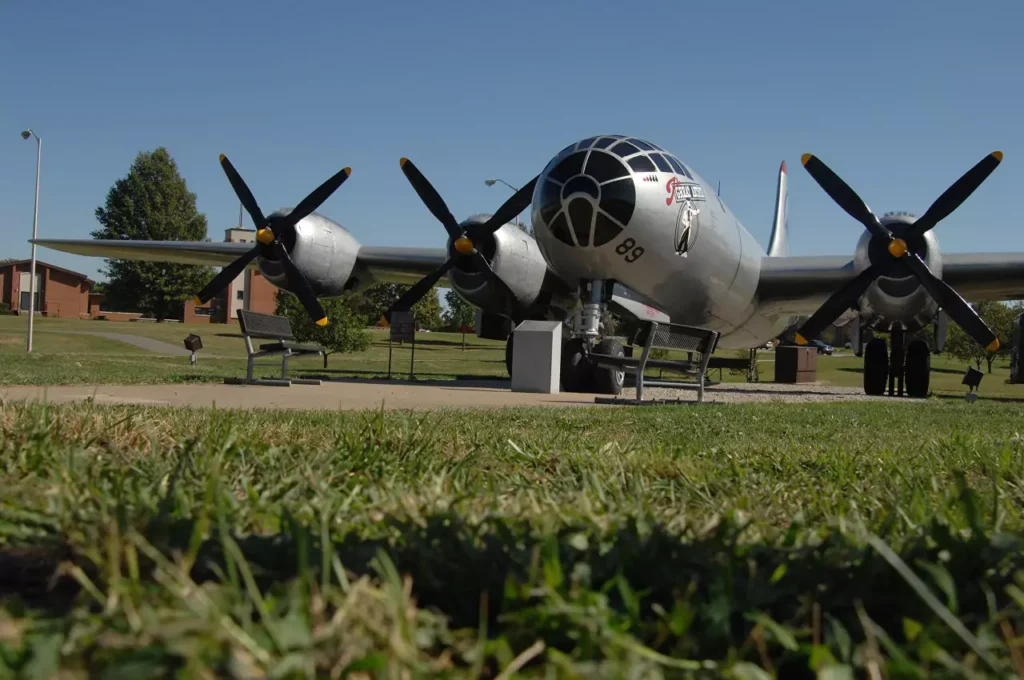
Eleven surviving B-29s are displayed outdoors, primarily at Air Force bases. In most instances, the museums housing these aircraft are not located on the US Air Force installations themselves and are accessible to the general public.
However, at Travis Air Force Base, foreign visitors (non-US residents) are required to register before gaining entry to visit the museum, a process that may take 3-5 weeks. Similarly, Barksdale Air Force Base mandates that visitors from foreign nations schedule their museum visits 30 days in advance.
As for The Great Artiste, it is situated on secured Whiteman AFB property and is not openly accessible to the public without prior access approval. Those interested in visiting should inquire with base security regarding photography access, credentials, and escort policies.
| Serial | Model | Name | Frame | Location | State | Source |
|---|---|---|---|---|---|---|
| 44-61535 | B-29A-35-BN | Raz'n Hell | Complete | Castle Air Museum in Castle AFB | California | China Lake |
| 42-65281 | B-29-25-MO | Miss America 62 | Complete | Travis Air Force Base Aviation Museum in Travis AFB | California | China Lake |
| 44-27343 | B-29-40-MO | Complete | Charles B. Hall Airpark in Tinker AFB | Oklahoma | Aberdeen PG |
|
| 44-61669 | B-29A-40-BN | Flagship 500 | Complete | March Field Air Museum in March Air Reserve Base | California | China Lake |
| 44-61671 | B-29A-40-BN | Great Artiste | Complete | Whiteman AFB | Missouri | Aberdeen PG |
| 44-62220 | B-29A-70-BN | Joltin’ Josie the Pacific Pioneer | Complete | Lackland Airpark in Lackland AFB | Texas | Aberdeen PG |
| 44-70113 | B-29-80-BW | Sweet Eloise | Complete | Dobbins Air Reserve Base | Georgia | Aberdeen PG |
| 44-86408 | B-29-55-MO | Straight Flush | Complete | Hill Aerospace Museum in Hill AFB | Utah | Dugway PG |
| 44-87627 | B-29-80-BW | Bossier City | Complete | Barksdale Global Power Museum in Barksdale Air Force Base | Louisiana | Aberdeen PG |
| 44-87779 | B-29-90-BW | Legal Eagle II | Complete | South Dakota Air and Space Museum in Ellsworth AFB | South Dakota | China Lake |
| 45-21748 | B-29-97-BW | Duke of Albuquerque | Complete | National Museum of Nuclear Science & History in Albuquerque | New Mexico | China Lake |
| 42-93967 | B-29A-15-BN | Dark Side | Complete | Georgia Veterans State Park in Cordale | Georgia | Aberdeen PG |
Flyable B-29s
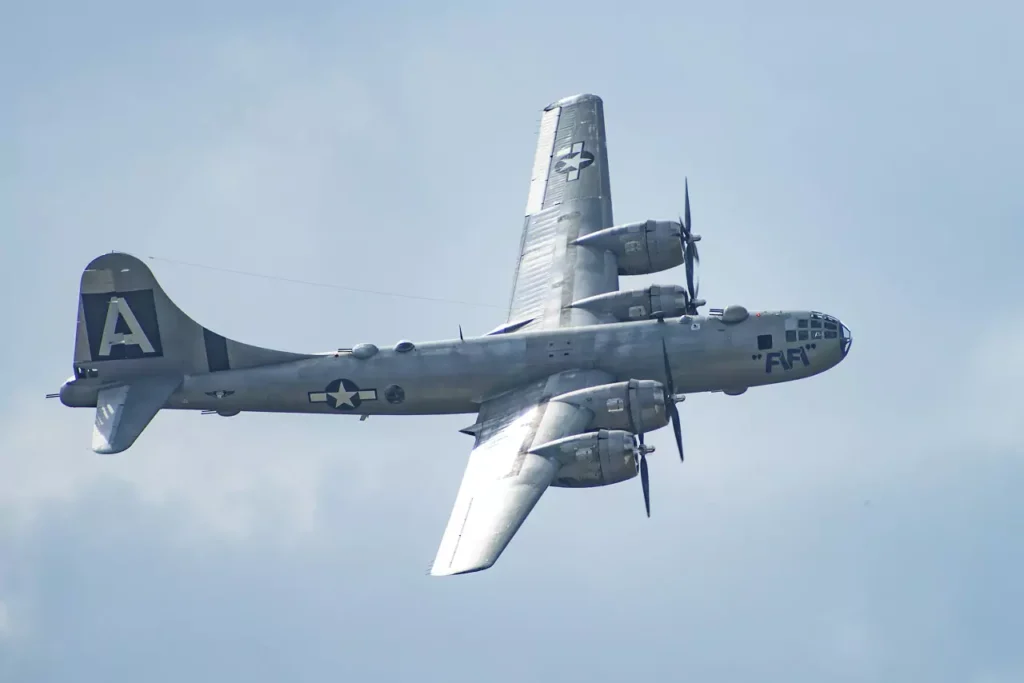
Currently, only two airworthy B-29s exist in the world, both of which offer the opportunity to arrange a flight. FiFi, stationed in Fort Worth, Texas, held the title of the sole flyable B-29 Superfortress for nearly five decades. This changed in 2016 with the restoration of Doc, now based in Wichita, Kansas.
FIFI
In 1966, the Confederate Air Force (CAF), later renamed the Commemorative Air Force in 2004, sought to include a B-29 Superfortress in its collection. They found several deteriorating aircraft at the Naval Weapons Center in China Lake, California.
After selecting one suitable for restoration, B-29A-60-BN 44-62070, the CAF underwent a lengthy paperwork process and had a maintenance crew work tirelessly on the aircraft. Despite Navy regulations preventing a test flight, the B-29 impressively completed its first flight in seventeen years in March 1971, covering a nonstop 1,250-mile journey from China Lake to Harlingen, Texas, without any issues.
The comprehensive restoration process took over three years, with volunteers dedicating months to repairing the aircraft. When completed, the bomber was christened FiFi in honor of the major financial sponsor Victor Agather’s wife.
The Commemorative Air Force has since toured FiFi around the United States for over thirty years. From 2005 to 2010, the aircraft underwent a major overhaul, ensuring it would continue to fly for another three decades.
If you want to reserve a seat in FIFI you can book it through the CAF’s National Air Tour of Historic WWII Aircraft site.
DOC
Doc, the second flyable B-29, is owned by aircraft enthusiast Tony Mazzolini. 44-69972 is named after the Snow White and the Seven Dwarfs character Doc.
In 1998, with the help of dozens of local volunteers, Mazzolini towed the Superfortress from China Lake ranges to Inyokern Airport. Two years later, Doc was transported to the Boeing plant in Wichita, Kansas, where it was originally built by McDonnell Aircraft Company in 1944.
The Boeing Company provided facilities and tools for the restoration, while volunteer aviation enthusiasts carried out the work. However, structural damage to the aircraft posed a significant challenge.
In 2016, Doc was successfully restored to airworthiness at the Kansas Aviation Museum and has since made appearances in a limited number of air shows.
When not flying, DOC is in “The B-29 Doc Hangar, Education and Visitors Center” at Eisenhower National Airport in Wichita, Kansas. You can plan your visit using Doc’s site.
B-29s on display outside of the United States
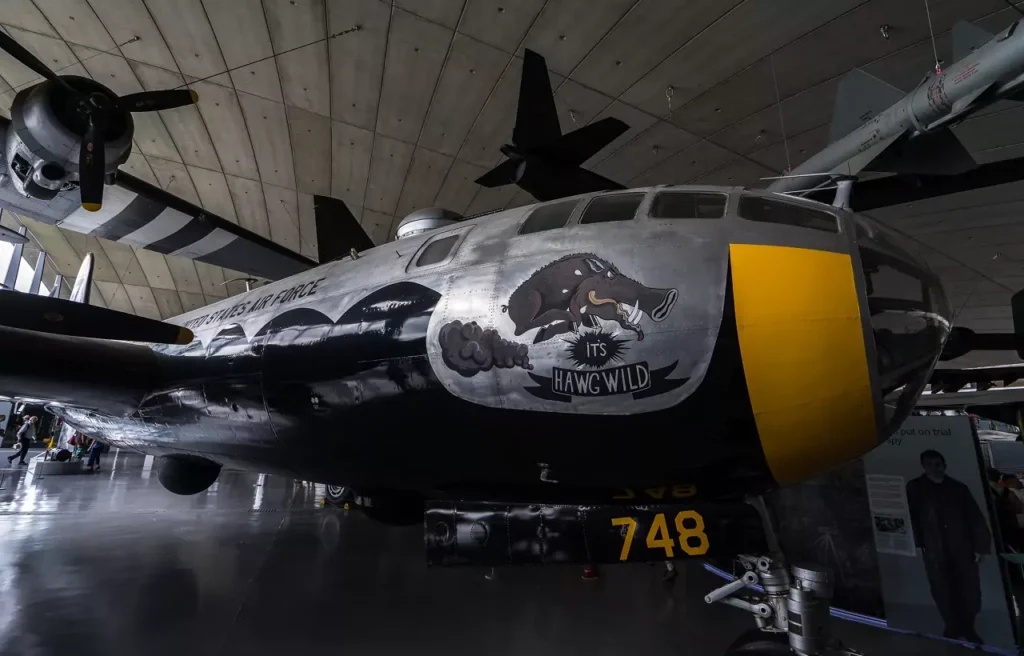
44-61748 Hawg Wild at the Imperial War Museum, Duxford, England (Photo by Falcon® Photography / CC BY-SA 2.0)
Apart from the numerous B-29s found in the United States, there are two additional notable examples located in England and South Korea.
The Imperial War Museum in Duxford, England, proudly displays a B-29 that was flown across the Atlantic after being salvaged from China Lake in California. Meanwhile, in South Korea, the UN Korean War Allies Association exhibits a B-29 that was disassembled and shipped also from China Lake.
| Serial | Model | Name | Frame | Location | State | Source |
|---|---|---|---|---|---|---|
| 44-61748 | B-29A-45-BN | Hawg Wild | Complete | Imperial War Museum in Duxford | England | China Lake |
| 45-21739 | B-29-90-BW | Complete | KAI Aerospace Museum in Sacheon | South Korea | China Lake |
South Korea
B-29 45-21739 is a China Lake Superfortress that was donated to the UN Korean War Allies Association and has been on display at their museum in Seoul, Korea since 1972. In March 1972, the aircraft was disassembled into 18 parts and shipped from China Lake, California to Seoul.
The Republic of Korea Air Force reassembled the B-29, and it was initially displayed at the Yoido Museum starting in August 1972. Later, in 1995, the aircraft was relocated to Sacheon. Upon its recovery in 1972 and placement in the Seoul Museum, the plane was named “Unification.”
England
B-29A-45-BN 44-61748, built too late for World War II, was actively involved in the Korean War. Known as “It’s Hawg Wild,” it flew 105 missions against North Korea from Kadena Air Base in Okinawa, Japan. In November 1956, the bomber arrived at China Lake and remained there for twenty years until the U.S. Navy gifted it to the Imperial War Museum in 1979.
The aircraft was then recovered and ferried to Tucson, Arizona, where it was prepared for the flight to Duxford. Initially, the Imperial War Museum considered dismantling the bomber and shipping it to the United Kingdom. However, Aero Services of Tucson, Arizona, offered to fly the plane to England for $10,000 less than the next lowest bid to dismantle and ship it, ultimately making the decision to fly the aircraft to its destination.
Fuselage sections on public display
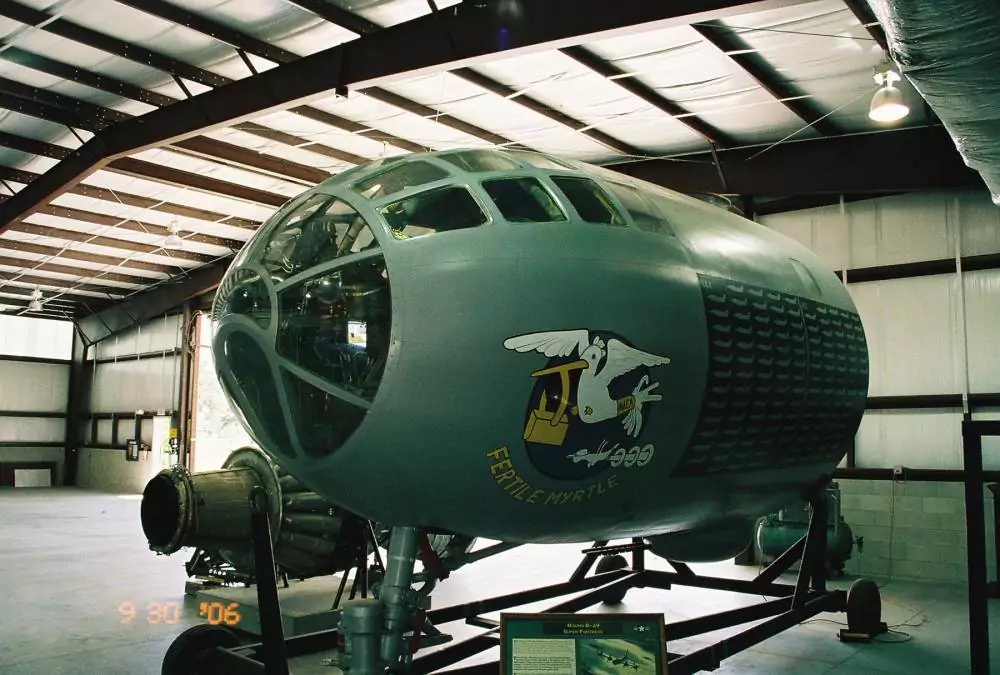
Several museums showcase sections of B-29 fuselage rather than complete aircraft.
The Fantasy of Flight Museum displays the nose section of a B-29 Superfortress (Serial No. 45-21787, Reg. No. N29KW) in its North Hangar.
The National Museum of the U.S. Air Force (NMUSAF) in Wright-Patterson AFB exhibits a B-29 fuselage painted in the colors of “Command Decision,” a veteran of the Korean Conflict which boasts five claimed victories against MiGs. This particular fuselage is open for walk-through inspection by visitors.
| Serial | Model | Name | Frame | Location | State | Notes | Source |
|---|---|---|---|---|---|---|---|
| 45-21787 | B-29-95-BW | Fertile Myrtle | Complete | Weeks Fantasy of Flight Museum in Polk City | Florida | Litchfield Park |
|
| 44-62139 | B-29A-65-BN | Command Decision | Partial | USAF Museum in Wright-Patterson AFB | Ohio | Forward fuselage painted to represent 44-87657 | Inventory |
Not easily accessible
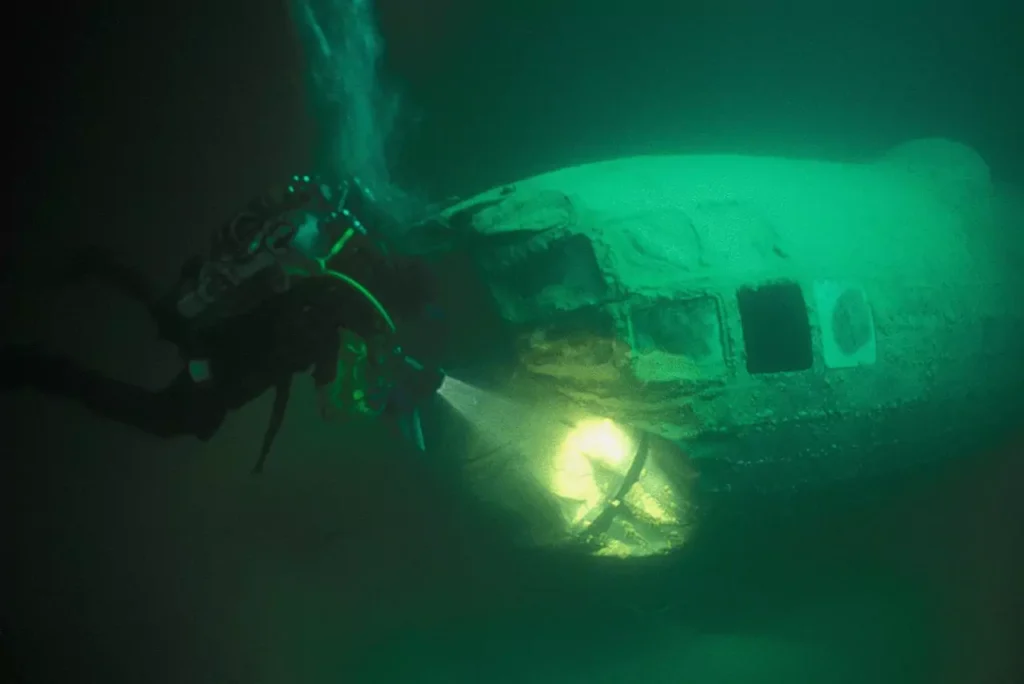
In the waters of Lake Mead, Nevada, diving enthusiasts have the unique opportunity to explore the wreck of a B-29 Superfortress. This Boeing B-29, 45-21847, crashed in the Overton Arm of Lake Mead in July 1948, and the National Park Service now serves as its custodian. Although the wreck is located below typical recreational diving depths, properly trained technical divers can access the site.
The aircraft is remarkably intact, aside from the loss of three engines during its ditching. The preservation level is impressive, with visible instrument readings, well-maintained aluminum skin and structural components, and a readable, shiny metal data plate on the engine.
The wreck is a sought-after destination for many wreck divers, and commercial tours are available through Las Vegas Scuba, LLC and Scuba Training and Technology Inc.
More information about visiting 45-21847 in National Park Service’s Historic Lake Mead B-29
Other wrecks include the “Lady in the Lake” in Eielson AFB in Fairbanks, Alaska, and Kee Bird in Greenland:
| Serial | Model | Name | Frame | Location | State | Notes | Source |
|---|---|---|---|---|---|---|---|
| 45-21768 | B-29-95-BW | Kee Bird | Partial | Greenland Ice Cap Fairbanks | Greenland | Inventory | |
| 44-62214 | B-29A-70-BN | Lady in the Lake | Partial | Eielson AFB in Fairbanks | Alaska | Also identified as 44-83905 | Inventory |
| 45-21847 | B-29-100-BW | Beetle Bomb | Partial | Lake Mead | Nevada | Inventory |
Various stages of completeness, not on display
Finally, the are other B-29s that are not on public display but are in storage:
| Serial | Model | Name | Frame | Location | State | Notes | Source |
|---|---|---|---|---|---|---|---|
| 44-70049 | Complete | In storage at Borrego Springs, for Kermit Weeks. | California | China Lake |
|||
| 42-65401 | Partial | Stockton Field Aviation Museum in Stockton | California | Nose section | |||
| 44-61739 | Partial | Museum of Aviation, Robbins AFB | Georgia | Nose section | |||
| 42-24791 | B-29-50-BW | Partial | In storage in Maryland for QuestMasters Online Museum. | Maryland | Nose section: The Big Time Operator; tail gunner’s compartment in private collection in California | China Lake | |
| 44-70102 | B-29-75-BW | Here’s Hopin | Partial | In storage at the Naval Museum of Armament and Technology in China Lake, Ridgecrest | California | China Lake | |
| 44-84084 | Partial | In storage at Borrego Springs, California, for Kermit Weeks. | California | Dugway PG |
|||
| 42-94052 | Partial | On the range at Dugway Proving Ground | Utah | Forward fuselage | |||
| 44-62112 | Partial | Pima Air and Space Museum in Tucson | Arizona |
Conclusion
In conclusion, the United States offers a wealth of opportunities for aviation enthusiasts and history buffs to witness the iconic B-29 Superfortress in various forms. Whether you live in the US or plan a visit, numerous museums and air bases showcase these impressive aircraft, with some even allowing walk-through inspections or displaying fuselage sections.
For a truly unique experience, enthusiasts can take to the skies aboard one of the two airworthy B-29s or even dive to explore the preserved wreck in Lake Mead, Alaska.
Regardless of your preferred mode of interaction, the surviving B-29s provide a fascinating window into an important chapter of aviation and military history.
Further reading
Bibliography
- Superfortress, the Boeing B-29 (Aircraft Specials series 6028) by Steve Birdsall
- Hidden Warbirds: The Epic Stories of Finding, Recovering, and Rebuilding WWII’s Lost by Nicholas A. Veronico
- Boeing B-29 Superfortress Manual 1942-60 (all marks): An insight into the design, operation, maintenance, and restoration of the USA’s giant long-range heavy bomber (Owners’ Workshop Manual) by Chris Howlett
- The B-29 Superfortress: A Comprehensive Registry of the Planes and Their Missions by Robert A. Mann
Now it is your turn
Have you ever visited one of these B-29s? or, are you planning a visit?
Or maybe you have a question.
Let me know by leaving a quick comment below right now.
Have all the surviving B-29’s been found? Is there any possibility of finding another one to be restored?